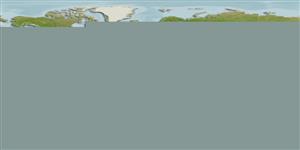Classification / Names
आम नाम | उपशब्द | Catalog of Fishes(वर्ग, प्रजाति) | ITIS | CoL | WoRMS | Cloffa
इलाज़मौबरांकी (शारक और रेज़) (sharks and rays) >
Squaliformes (Sleeper and dogfish sharks) >
Squalidae (Dogfish sharks)
Etymology: Squalus: Genus name from Latin 'squalus' meaning shark (Ref. 6885, 27436); albifrons: Name from Latin 'albi' for white and 'frons' for brow, referring to the white upper ocular margin in most specimens where denticles have been shed..
More on authors: Last, White & Stevens.
Environment: milieu / climate zone / depth range / distribution range
पारिस्थितिकी
समुद्री; गहराई सीमा 131 - 450 m (Ref. 58440). Tropical
Western Pacific: eastern Australia.
आकार / वज़न / Age
Maturity: Lm ? range ? - ? cm
Max length : 74.0 cm TL पुल्लिंग / अलिंग; (Ref. 58440); 86.0 cm TL (female)
Short description
पहचान कुंजी | आकृति विज्ञान | मौरफोमैटरिक्स
This large species belonging to the 'highfin megalops group' has the following set of characters: abdomen depth 10.4-12.6% TL; pre-vent length 46.9-48.1% TL, 2.0-2.2 times dorsal caudal margin; pre-second dorsal length 3.7-4.3 times the pectoral-fin anterior margin, 2.5-2.8 times dorsal caudal margin; head width 1.0-1.4 times abdomen width; preoral length 2.9-3.1 times horizontal prenarial length, 8.4-9.1% TL; head length 4.3-4.9 times its eye length; mouth width 3.3-4.1 times length of upper labial furrow; interorbital width 1.5-1.7 times the horizontal preorbital length; fifth gill slit height 2.1-2.5% TL; strongly bifurcated anterior nasal flap; first dorsal fin upright, upper posterior margin directed posteroventrally, greatest concavity about midway between free rear tip and fin apex; posterior margin of second dorsal fin deeply concave; second dorsal-fin spine with a broad base; pectoral fin of adult not falcate, anterior margin long, 14.2-15.8% TL; dorsal surface dark, sharply demarcated from paler ventral surface on side of head; dorsal fins are dark with obvious darker tips; first dorsal-fin spine distinctly paler than the base of soft portion of dorsal fin; caudal fin with broad white posterior margin, caudal bar absent; flank denticles weakly tricuspid; monospondylous centra 44-46, precaudal centra 89-93, total centra 116-122 (Ref. 58440).
Life cycle and mating behavior
Maturities | पुनरुत्पत्ति | Spawnings | Egg(s) | Fecundities | लार्वा
Distinct pairing with embrace (Ref. 205).
Last, P.R., W.T. White and J.D. Stevens, 2007. New species of Squalus of the 'highfin megalops group' from the Australasian region. p. 39-53. In P.R. Last, W.T. White and J.J. Pogonoski Descriptions of new dogfishes of the genus Squalus (Squaloidea:Squalidae). CSIRO Marine and Atmospheric Research Paper No. 014. 130 p. (Ref. 58440)
IUCN Red List Status (Ref. 130435)
Threat to humans
Harmless
Human uses
साधन
Special reports
Download XML
इंटरनेट स्रोत
Estimates based on models
Preferred temperature (Ref.
123201): 13 - 21.4, mean 19 °C (based on 34 cells).
Phylogenetic diversity index (Ref.
82804): PD
50 = 0.5000 [Uniqueness, from 0.5 = low to 2.0 = high].
Bayesian length-weight: a=0.00339 (0.00162 - 0.00707), b=3.10 (2.93 - 3.27), in cm total length, based on LWR estimates for this Genus-body shape (Ref.
93245).
Trophic level (Ref.
69278): 4.3 ±0.4 se; based on size and trophs of closest relatives
लौटाव (Ref.
120179): बहुत नीचे, न्यूनतम जनसंख्या दुगनी समय अवलागत 14 महीने। (Preliminary K or Fecundity.).
Fishing Vulnerability (Ref.
59153): Moderate to high vulnerability (54 of 100).
